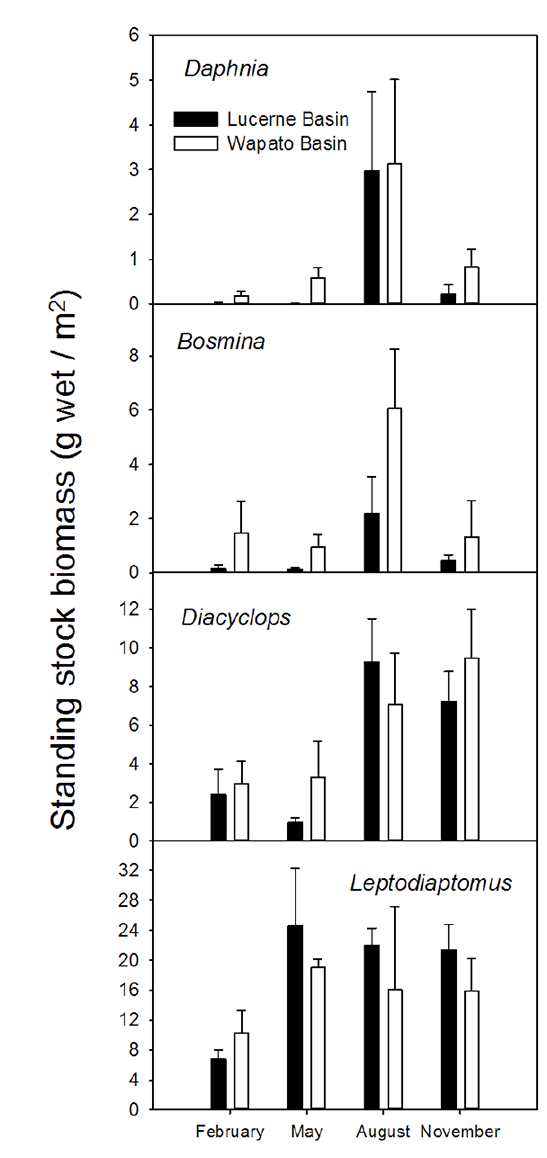
Ecological Archives A025-122-A1
Erik R. Schoen, David A. Beauchamp, Anna R. Buettner, and Nathanael C. Overman. 2015. Temperature and depth mediate resource competition and apparent competition between Mysis diluviana and kokanee. Ecological Applications 25:1962–1975. http://dx.doi.org/10.1890/14-1822.1
Appendix A. Zooplankton analysis: detailed methods, model selection results, and standing stock biomass figure.
We identified, enumerated, and measured subsamples of each zooplankton sample. We counted eggs attached to or contained within individual zooplankton of each taxon. Loose eggs were identified as cladoceran or copepod based on size and assigned to taxa within those groups based on the proportion of adults in the sample. We measured a subsample of zooplankton of each taxon from the base of the helmet to the base of the tail spine or setae using an ocular micrometer. We estimated the wet mass of each taxon from length data using taxa-specific length-mass relationships and a wet : dry mass ratio of 10:1 (Dumont et al. 1975, Rieman and Falter 1981). We estimated the efficiency of the zooplankton net as 33.8% ± 2.0% (mean ± SE) by comparison with a metered Clarke-Bumpus sampler (Clarke and Bumpus 1950). For this comparison, we sampled zooplankton from 10 m to the surface with seven replicate vertical hauls using the ring net and one oblique tow with the Clarke-Bumpus sampler conducted at the same time and location. The Clarke-Bumpus tow followed a widely curved path to ensure that it cut across Langmuir cells, reducing fine-scale patchiness (Edmondson and Litt 1982).
Literature Cited
Clarke, G., and D. Bumpus. 1950. The plankton sampler—an instrument for quantitative plankton investigation. Limnological Society of America Special Publication 5:8.
Dumont, H. J., I. Vandevelde, and S. Dumont. 1975. Dry weight estimate of biomass in a selection of Cladocera, Copepoda and Rotifera from plankton, periphyton and benthos of continental waters. Oecologia 19:75–97.
Edmondson, W., and A. H. Litt. 1982. Daphnia in Lake Washington. Limnology and Oceanography 27:272–293.
Rieman, B. E., and C. M. Falter. 1981. Effects of the establishment of Mysis relicta on the macrozooplankton of a large lake. Transactions of the American Fisheries Society 110:613–620.
Table A1. Model selection results evaluating the effects of season, lake basin, or a combination of these factors on the adult density, egg density, and body length of Daphnia and Bosmina.
Model |
k |
-2l |
AICc |
ΔAICc |
wi |
Daphnia adult density |
|||||
Season |
5 |
178.6 |
191.0 |
7.43 |
0.015 |
Basin |
3 |
188.3 |
195.2 |
11.68 |
0.002 |
Season + Basin |
6 |
168.1 |
183.6 |
0 |
0.603 |
Season + Basin + Season×Basin |
9 |
157.9 |
184.5 |
0.92 |
0.381 |
Bosmina adult density |
|||||
Season |
5 |
232.3 |
244.7 |
4.23 |
0.105 |
Basin |
3 |
242.1 |
249.0 |
8.50 |
0.012 |
Season + Basin |
6 |
225.0 |
240.5 |
0 |
0.868 |
Season + Basin + Season×Basin |
9 |
222.0 |
248.6 |
8.14 |
0.015 |
Daphnia egg density |
|||||
Season |
5 |
108.2 |
120.7 |
5.64 |
0.040 |
Basin |
3 |
118.1 |
125.0 |
9.93 |
0.005 |
Season + Basin |
6 |
99.4 |
115.1 |
0 |
0.671 |
Season + Basin + Season×Basin |
9 |
89.8 |
116.8 |
1.75 |
0.280 |
Bosmina egg density |
|||||
Season |
5 |
138.6 |
151.1 |
3.01 |
0.104 |
Basin |
3 |
141.5 |
148.4 |
0.34 |
0.396 |
Season + Basin |
6 |
132.4 |
148.1 |
0 |
0.469 |
Season + Basin + Season×Basin |
9 |
126.5 |
153.5 |
5.42 |
0.031 |
Daphnia body length |
|||||
Season |
5 |
-133.76 |
-123.58 |
0 |
0.63 |
Basin |
3 |
-95.14 |
-89.08 |
34.5 |
0 |
Season + Basin |
6 |
-133.88 |
-121.65 |
1.93 |
0.24 |
Season + Basin + Season×Basin |
9 |
-138.86 |
-120.34 |
3.24 |
0.13 |
Bosmina body length |
|||||
Season |
5 |
45.2 |
55.45 |
6.62 |
0.03 |
Basin |
3 |
64.86 |
70.97 |
22.13 |
0 |
Season + Basin |
6 |
39.48 |
51.82 |
2.99 |
0.18 |
Season + Basin + Season×Basin |
9 |
30.08 |
48.83 |
0 |
0.79 |
Notes: Values shown for each model include the number of parameters k, the log likelihood l, the differences of the corrected Akaike’s information criterion among models (ΔAICc), and Akaike weights (wi). Values in bold italics correspond to the best-fitting models (i.e., ΔAICc ≤ 2).
Fig. A1. Seasonal standing stock biomass of primary cladoceran (Daphnia and Bosmina) and copepod (Diacyclops and Leptodiaptomus) taxa in Lucerne and Wapato Basins. Bars represent means plus one standard error.